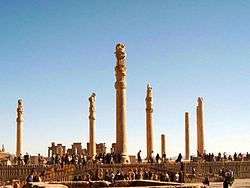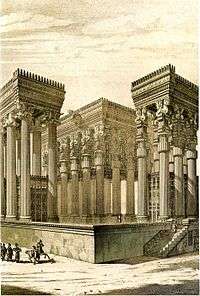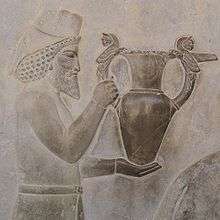Apadana


An Apadana (Old Persian: 𐎠𐎱𐎭𐎠𐎴) is a large hypostyle hall, the best known examples being the great audience hall and portico at Persepolis and the palace of Susa. The Persepolis Apadana belongs to the oldest building phase of the city of Persepolis, the first half of the 6th century BC, as part of the original design by Darius the Great. Its construction completed by Xerxes I. Modern scholarships "demonstrates the metaphorical nature of the Apadana reliefs as idealised social orders".[1]
The term "apadana"
As a word, "apadāna" (Old Persian𐎠𐎱𐎭𐎠𐎴, masc.) is used to designate a hypostyle hall, i.e., a palace or audience hall of stone construction with columns. The word is rendered in Elamite as ha-ha-da-na and in Babylonian ap-pa-da-an is etymologically ambiguous. It has been compared to the Sanskrit "apadana" ( आपादन) which means 'to arrive at', and also to the Sanskrit apa-dhā ( अपधा) which means "a hide-out or concealment", and the Greek apo-thēkē "storehouse". The word survived into later periods in Iran, as the Parthian 'pdn(y) or 'pdnk(y) "palace", and outside Iran it still survives in several languages as loan-words (including the Arabic fadan, the Armenian aparan-kʿ "palace".)[2]
More precisely, however, this word is the direct ancestor of the medieval and modern architectural term, ayvan/aywan. The Old Persian term 𐎠𐎱𐎭𐎠𐎴, a-pad-an, standing for "unprotected", refers to the fact that the veranda-shaped structure is open to the outside elements on one of its four sides, and thus 'unprotected' / exposed to the natural elements. This is exactly what the Apadana palace has: open (columned) verandas on three sides—a unique feature among all palace buildings at Persepolis. The Parthian and Sasanian architects largely did away with the columns holding up the ceiling of the veranda, replacing them with a barrel vaulting, such as the famous Ayvan of Kisra at Ctesiphon. The later evolution of term into aywan in the post-Islamic architecture that evolved from the old "apadana", refers to both columned (such as the palace of Chehel Sotoun, Isfahan) or barrel vaulted (all the four-aywaned mosques). Like the old Apadana, the new aywans are also verandas: open to the natural elements on one side.
As a modern architectural and archaeological term, the word "apadana" is also used to refer to Urartian hypostyle halls, such as those excavated at Altintepe and Erebuni. These halls predate those from Persia, and it has been proposed that Urartu could be the stylistic origin of the later Persian hypostyle audience halls.[3]
Description
The Apadana was the largest building on the Terrac at Persepolis and was excavated by the German archaeologist Ernst Herzfeld and his assistant Friedrich Krefter, and Erich Schmidt, between 1931 and 1939. Important material relevant to the excavations are today housed in the archives of the Freer Gallery of Art in Washington, DC.
It was most likely the main hall of the kings. The columns reached 20m high and had complex capitals in the shape of bulls or lions. Here, the great king received the tribute from all the nations in the Achaemenid Empire, and gave presents in return.
Access to the hall is given by two monumental stairways, on the north and on the east. These are decorated by reliefs, showing delegates of the 23 subject nations of the Persian Empire paying tribute to Darius I, who is represented seated centrally. The various delegates are shown in great detail, giving insight into the costume and equipment of the various peoples of Persia in the 5th century BC. There are inscriptions in Old Persian and Elamite.
Measurements
The Apadana at Persepolis has a surface of 1000 square metres; its roof was supported by 72 columns, each 24 metres tall. The entire hall was destroyed in 331 BC by the army of Alexander the Great. Stones from the columns were used as building material for nearby settlements. By the start of the 20th century, only 13 of these giant columns were still standing. The re-erecting of a complete, but fallen column in the 1970s, is now the 14th standing column of the Apadana.
The Apadana in Susa was — like the city itself — largely abandoned, and pillaged for building material.
Notes
- ↑ M. Root (1986) p. 1.
- ↑ R. Schmitt, Apadana i. Term, in Encyclopaedia Iranica
- ↑ Henri Stierlin, "Greece, from Mycenae to the Parthenon (Taschen's World Architecture)", 1997. p116.
References
| Wikimedia Commons has media related to Apadana of Persepolis. |
External links
- Oriental Institute Photographic Archives
- The Achaemenians continued
- Persepolis3D, a virtual reconstruction of Apadana
Coordinates: 29°56′06″N 52°53′24″E / 29.935°N 52.890°E
